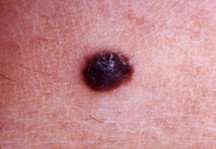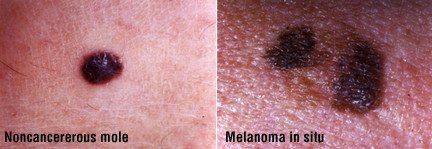Moles (nevi)
Medically reviewed by Drugs.com. Last updated on Dec 4, 2023.
What are Moles (nevi)?

Moles are small, pigmented spots on the skin that usually appear during childhood or adolescence, although they are sometimes present at birth. They are composed of clusters of pigmented cells called melanocytes. People may develop more moles during adolescence and pregnancy, and existing ones may enlarge or darken somewhat during these times. Despite such changes, moles should always remain:
- Evenly pigmented — The color is the same across the mole
- Sharply demarcated — The edges of the mole are clear-cut
- Symmetrical in shape and color — All parts of the mole look similar.
|
|
Symptoms
Moles can vary in color. They can be flesh-colored, yellow-brown or dark brown. They also can be flat or raised and can be smooth, hairy or warty. Although moles usually are harmless, in some cases they can become cancerous, causing a potentially deadly tumor called malignant melanoma. For this reason, it is important to monitor moles and have them examined by a dermatologist if they:
- get larger suddenly
- develop an irregular border
- become darker or inflamed
- show spotty color changes
- begin to bleed, crack or itch
- become painful.
Moles called atypical moles, or dysplastic nevi, have somewhat different physical characteristics and sometimes run in families. They are more likely than common moles to turn into cancer. People with multiple dysplastic nevi and melanoma in two or more first-degree relatives have 25 times the risk of developing melanoma. This is called the dysplastic nevus-melanoma syndrome.
Diagnosis
Your doctor can determine the type of mole you have by looking at it.
Common moles usually are no more than 1 to 10 millimeters (less than half an inch) in diameter. They are flesh-colored, yellow-brown, or dark brown and can be located anywhere on the body. They usually appear during childhood or adolescence.
Atypical moles (dysplastic nevi) are usually larger in diameter (5 millimeters to 12 millimeters). They are tan to dark brown and may have a mixture of colors, including tan, dark brown, and sometimes pink or black. The border is often irregular and indistinct, and often fades into the surrounding skin. Most commonly, atypical moles appear on sun-exposed skin, but they can occur elsewhere, and they continue to develop after age 35.
Expected duration
Most moles never become a problem. However, moles should be inspected regularly for any abnormal changes.
Prevention
When melanocytes become cancerous, they are called melanomas. It is important to examine your moles regularly to look for any suspicious changes. Get someone else to inspect your scalp and other areas that are hard to see. Watch for the early warning signs of melanoma by using the ABCDE criteria:
- Asymmetry
- Border irregularities
- Color variation (different colors within the same mole)
- Diameter greater than 6 millimeters (larger than a pencil eraser)
- Evolving (a new mole developing).
Practice safe sunning. Never sunbathe or visit a suntan parlor for the sake of tanning. Use high-SPF sunscreen when outdoors, wear protective hats and clothing, and avoid the outdoors when the sun is most intense, from 11 a.m. to 3 p.m. Sweating or swimming can cause sunscreen to wash off, even if it is labeled as "waterproof." Reapply sunscreen often.
|
|
Treatment
Common moles do not need to be removed. However, some people choose to have them removed for cosmetic reasons; if they are raised and located in areas where clothing irritates them, such as the waistline; or if they are on the scalp and are irritated by hair brushing. Most moles can be cut off in a simple in-office procedure. Moles and dysplastic nevi whose appearance suggests they may be cancerous should be removed and examined under a microscope. If they are found to be cancerous, additional skin in the surrounding area also must be removed.
When to call a professional
Do not ignore warning signs. Have suspicious moles checked by a dermatologist. Melanoma is the deadliest form of skin cancer, but early diagnosis could save your life. If a mole appears abnormal, your doctor will do a biopsy by taking some of the mole tissue so it can be examined in a laboratory. Also, having a doctor check your moles once is not enough. Normal-looking moles can become cancerous later. Moles must be examined from time to time, especially if you notice any changes. If you have dysplastic nevi or if there is a history of melanoma in your family, you should have a physician check all of your moles regularly. Your physician will recommend how often you should have them checked.
Prognosis
Since moles can become cancerous, it is important to see a dermatologist if a mole changes.
Additional info
American Academy of Dermatology
https://www.aad.org/
Further information
Always consult your healthcare provider to ensure the information displayed on this page applies to your personal circumstances.


